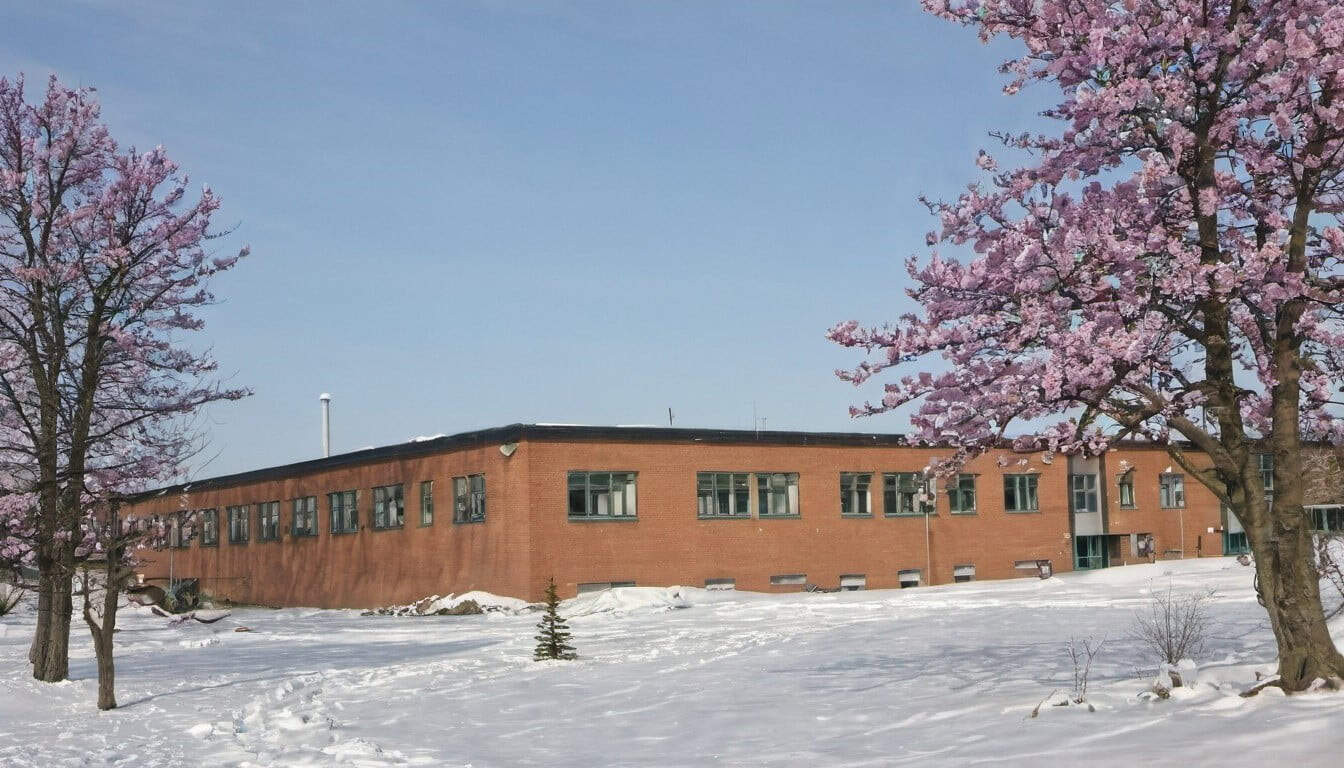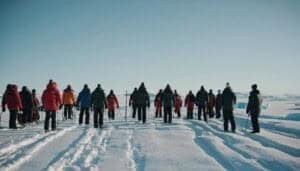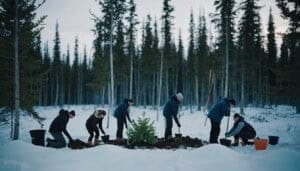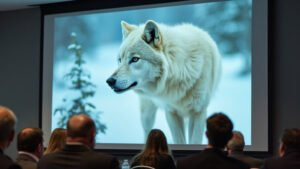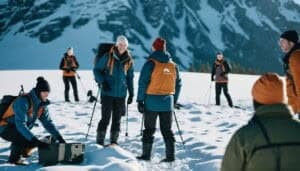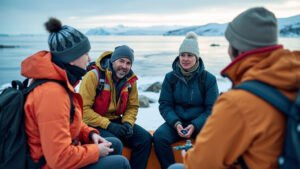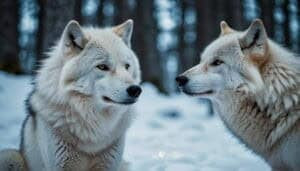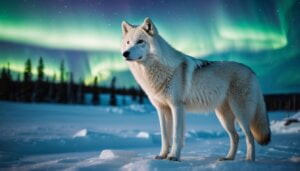Introduction
Local schools can play a pivotal role in Arctic wolf conservation by integrating educational programs, fostering school clubs, organizing community service projects, and collaborating with conservation organizations
This article explores various ways schools can contribute, from incorporating Arctic wolf studies into the curriculum to using technology for conservation promotion
Additionally, it examines how science curricula and student initiatives can drive awareness and action, ultimately supporting the preservation of these majestic creatures and their habitats
Educational Programs for Arctic Wolf Awareness
Local schools can significantly contribute to Arctic wolf conservation through well-structured educational programs. These programs aim to raise awareness among students, encouraging them to become advocates for wildlife preservation
By integrating Arctic wolf studies into various subjects, organizing special events, and inviting experts to speak, schools can foster a deep understanding of the importance of conserving these animals
Integrating Arctic Wolf Studies into the Curriculum
Incorporating Arctic wolf studies into the school curriculum can make a lasting impact. Teachers can design lesson plans that highlight the biology, ecology, and conservation status of Arctic wolves
For example, in science classes, students can learn about the wolf’s role in the ecosystem, their hunting patterns, and the challenges they face due to climate change and human activities. History and social studies classes can explore the cultural significance of wolves in Indigenous communities and the historical context of wolf conservation efforts
To make learning interactive, educators can employ project-based learning approaches. Students might create research projects, presentations, or multimedia reports on various aspects of Arctic wolf life. Additionally, schools can establish partnerships with wildlife conservation organizations to provide students with access to real-world data and resources, enhancing the educational experience
Special Events and Workshops
Special events and workshops dedicated to Arctic wolf conservation can capture students’ interest and inspire action
Schools can organize themed weeks where each day focuses on a different aspect of Arctic wolf conservation. Activities might include documentary screenings, art contests, and interactive sessions with conservationists. These events can be open to the broader community, thereby extending the reach of the conservation message
Workshops can provide hands-on experiences, such as building models of Arctic habitats or simulating tracking and monitoring techniques used by wildlife biologists. By engaging in these practical activities, students gain a deeper appreciation for the complexities of conservation work and the importance of preserving natural habitats
Guest Speakers and Experts
Inviting guest speakers who are experts in the field of wildlife conservation can have a profound impact on students
Biologists, researchers, and representatives from conservation organizations can share their firsthand experiences and knowledge about Arctic wolves. These sessions can be tailored to different age groups, ensuring that the content is both engaging and educational
Guest speakers can also participate in Q&A sessions, allowing students to ask questions and gain insights into the real-world challenges and triumphs of conservation efforts. These interactions can inspire students to consider careers in wildlife biology, environmental science, and conservation, further extending the impact of the school’s efforts
By incorporating Arctic wolf studies into the curriculum, organizing special events, and inviting experts to speak, schools can create a dynamic and impactful educational program. These initiatives not only raise awareness about Arctic wolf conservation but also empower students to take active roles in preserving wildlife and their habitats
School Clubs and Organizations
School clubs and organizations provide a dynamic platform for students to engage in Arctic wolf conservation efforts
These groups can spearhead various initiatives, encouraging students to take an active role in preserving wildlife. By forming environmental clubs, launching student-led conservation projects, and collaborating with local wildlife groups, schools can foster a community dedicated to protecting Arctic wolves
Environmental Clubs
Environmental clubs in schools are ideal for promoting Arctic wolf conservation
These clubs can organize regular meetings where members discuss current conservation issues, plan events, and share knowledge about Arctic wolves. Activities could include fundraising campaigns, awareness drives, and educational workshops
One effective strategy is to establish a “Wolf Week,” during which club members lead activities such as creating informative posters, hosting debates on conservation policies, and screening documentaries about Arctic wolves. Club members can also collaborate with teachers to integrate conservation topics into classroom discussions, ensuring the entire school is involved
Environmental clubs can also participate in local and national conservation programs, providing students with opportunities to contribute to broader efforts. By engaging in these activities, students develop leadership skills and a sense of responsibility towards environmental stewardship
Student-Led Conservation Initiatives
Empowering students to lead conservation initiatives can significantly impact Arctic wolf preservation
Schools can encourage students to develop their own projects, such as organizing clean-up drives, tree planting events, or awareness campaigns within the community. These initiatives can focus on educating the public about the importance of Arctic wolves and the need to protect their habitats
Students can also create digital campaigns using social media platforms to reach a wider audience. By designing engaging content such as infographics, videos, and blogs, they can spread awareness and gather support for Arctic wolf conservation. Schools can provide resources and guidance to help students effectively plan and execute these projects
Additionally, student-led initiatives can include collaborative projects with other schools, creating a network of young conservationists working towards a common goal. This not only amplifies the impact of their efforts but also fosters a sense of unity and shared purpose
Collaboration with Local Wildlife Groups
Partnering with local wildlife groups can enhance the effectiveness of school conservation efforts
These collaborations provide students with access to expert knowledge, resources, and real-world conservation activities. Schools can arrange field trips to wildlife reserves, conservation centers, and research facilities where students can observe Arctic wolves and learn about ongoing conservation projects
Local wildlife groups can also offer mentorship programs, internships, and volunteer opportunities for students. By working alongside professionals, students gain practical experience and a deeper understanding of the challenges and successes in wildlife conservation. This hands-on involvement can be a powerful motivator, inspiring students to pursue careers in environmental science and conservation
Moreover, schools can host joint events with wildlife groups, such as community lectures, conservation fairs, and fundraising events. These collaborations not only strengthen the school’s conservation initiatives but also build a strong support network within the community
By establishing environmental clubs, supporting student-led conservation initiatives, and collaborating with local wildlife groups, schools can create a robust framework for Arctic wolf conservation. These efforts empower students to take meaningful action, fostering a lifelong commitment to wildlife preservation
Community Service Projects
Community service projects initiated by schools can play a crucial role in Arctic wolf conservation
These projects allow students to directly engage with conservation efforts, raising awareness and actively contributing to the preservation of Arctic wolves and their habitats. Schools can undertake habitat restoration projects, launch awareness campaigns, and involve parents and community members to amplify their impact
Habitat Restoration Projects
Habitat restoration projects are an effective way for schools to contribute to Arctic wolf conservation
These projects can include activities such as planting native vegetation, cleaning up natural areas, and creating wildlife corridors. By restoring and protecting habitats, students help ensure that Arctic wolves and other wildlife have the necessary resources to thrive
Schools can collaborate with local environmental organizations to identify areas in need of restoration and develop project plans. Students can participate in field trips to these sites, where they can learn about the ecosystem, the importance of biodiversity, and the specific needs of Arctic wolves. Hands-on activities, such as planting trees and removing invasive species, provide students with a tangible sense of accomplishment and a direct connection to conservation efforts
Awareness Campaigns
Raising awareness about Arctic wolf conservation is essential for garnering community support and action. Schools can spearhead awareness campaigns to educate the public about the threats facing Arctic wolves and the importance of protecting their habitats. These campaigns can take various forms, including social media outreach, community events, and educational presentations
Students can create informative materials such as brochures, posters, and videos to share with their peers, families, and the broader community
Organizing events like conservation fairs, where experts and environmental organizations can present information and resources, can also be highly effective. These campaigns not only increase public knowledge but also inspire community members to get involved in conservation efforts
Involving Parents and Community Members
Engaging parents and community members in school-led conservation projects can significantly enhance their impact. Schools can organize family-oriented activities such as weekend habitat restoration events, wildlife observation trips, and educational workshops. These events provide opportunities for families to learn together and contribute to conservation efforts
Parent-teacher associations (PTAs) and local community groups can play a supportive role by providing resources, volunteer support, and funding for conservation projects. Schools can also invite community members with expertise in environmental science, wildlife conservation, and related fields to participate in school events and share their knowledge
Involving the broader community creates a network of support for Arctic wolf conservation, fostering a collective sense of responsibility and action. This community engagement helps ensure that conservation efforts are sustained and amplified beyond the school environment
By undertaking habitat restoration projects, launching awareness campaigns, and involving parents and community members, schools can create impactful community service projects that support Arctic wolf conservation. These initiatives not only contribute to the preservation of Arctic wolves but also foster a culture of environmental stewardship among students and their communities
Collaborations with Conservation Organizations
Collaborations between schools and conservation organizations can significantly bolster Arctic wolf conservation efforts. These partnerships provide students with invaluable resources, knowledge, and opportunities to engage in meaningful conservation activities
Schools can partner with non-profits, participate in joint educational initiatives, and explore sponsorship and grant opportunities to enhance their conservation impact
Partnering with Non-Profits
Partnering with non-profit organizations dedicated to wildlife conservation allows schools to access specialized expertise and resources. These organizations can offer educational materials, guest speakers, and hands-on conservation projects tailored to students
For example, schools can work with non-profits that focus on Arctic wolf conservation to develop curriculum content, organize workshops, and arrange field trips
Non-profit organizations often run ongoing conservation programs that schools can join. Students can participate in citizen science projects, such as monitoring local wildlife populations or collecting data on environmental conditions. These activities provide practical experience and contribute to larger conservation efforts, making students feel like integral parts of the mission
Joint Educational Initiatives
Joint educational initiatives between schools and conservation organizations can enhance learning experiences and promote Arctic wolf conservation. These initiatives can include collaborative research projects, co-hosted events, and shared resources
For instance, schools can collaborate with conservation organizations to create interactive learning modules on Arctic wolves, covering topics like their biology, habitat needs, and the impact of climate change
Schools can also co-host conservation events with these organizations, such as community lectures, film screenings, and conservation fairs. These events can feature experts from the field, providing students and the community with insights into ongoing conservation efforts and ways to get involved
Additionally, conservation organizations can offer training sessions for teachers, equipping them with the latest information and teaching methods related to Arctic wolf conservation
Sponsorship and Grant Opportunities
Securing sponsorships and grants can provide essential funding for school-based Arctic wolf conservation projects. Conservation organizations often have access to funding sources that can support educational and community initiatives. Schools can apply for grants to finance projects such as habitat restoration, awareness campaigns, and student-led research
Sponsorship from local businesses and community groups can also provide financial support and resources. Schools can organize fundraising events, such as charity runs, bake sales, and silent auctions, with proceeds going towards Arctic wolf conservation projects. These events can raise funds and increase public awareness and support for the cause
Grant applications can be collaborative efforts between schools and conservation organizations. By working together, they can develop compelling proposals that highlight the educational and environmental benefits of their projects. Successful grant applications can lead to long-term partnerships and sustained funding for ongoing conservation efforts
By partnering with non-profits, participating in joint educational initiatives, and securing sponsorships and grants, schools can significantly enhance their Arctic wolf conservation efforts. These collaborations provide students with rich educational experiences and empower them to contribute meaningfully to wildlife preservation
Role of Science Curricula
Integrating Arctic wolf conservation into the science curricula can profoundly impact students’ understanding and involvement in wildlife preservation. By incorporating conservation science, providing hands-on learning experiences, and promoting research projects, schools can cultivate a generation of informed and active conservationists
Incorporating Conservation Science
Integrating conservation science into the science curriculum allows students to explore the principles and practices of wildlife preservation
Teachers can design lesson plans that cover topics such as ecosystems, biodiversity, and the specific needs and challenges of Arctic wolves. This foundational knowledge helps students understand the broader context of conservation efforts
For example, a unit on ecosystems can include a case study on the Arctic tundra, examining the interdependent relationships between Arctic wolves, their prey, and the environment. Students can learn about the impact of climate change on these ecosystems and the adaptive strategies of Arctic wolves
By understanding these dynamics, students appreciate the complexity of conservation efforts and the importance of maintaining balanced ecosystems
Hands-On Learning Experiences
Hands-on learning experiences are essential for engaging students in Arctic wolf conservation. Schools can organize field trips to wildlife reserves, conservation centers, and natural history museums where students can observe Arctic wolves and learn about their habitats. These trips provide practical insights into the daily work of conservationists and the real-world challenges they face
Classroom activities can also include interactive projects such as building models of Arctic habitats, simulating wildlife tracking techniques, and conducting experiments related to environmental science
For instance, students can simulate the effects of temperature changes on Arctic wolf prey populations, illustrating the impact of climate change on the food web. These activities make learning tangible and memorable, reinforcing the importance of conservation
Research Projects on Arctic Wolves
Encouraging students to undertake research projects on Arctic wolves can deepen their knowledge and foster critical thinking skills
These projects can range from literature reviews and data analysis to fieldwork and experiments. Students can investigate various aspects of Arctic wolf biology, behavior, and conservation, such as the genetic diversity of wolf populations or the effectiveness of different conservation strategies
Schools can facilitate these projects by providing access to scientific journals, databases, and research tools. Collaboration with local universities and research institutions can offer students additional resources and mentorship opportunities. Presenting their findings at school science fairs or community events allows students to share their work and contribute to the broader conversation on Arctic wolf conservation
Moreover, research projects can include participation in citizen science initiatives, where students contribute data to larger studies conducted by conservation organizations. This involvement gives students a sense of ownership and responsibility, knowing their work has a direct impact on ongoing conservation efforts
By incorporating conservation science into the curriculum, offering hands-on learning experiences, and promoting research projects, schools can effectively engage students in Arctic wolf conservation. These educational approaches not only enhance students’ understanding but also inspire them to become active participants in wildlife preservation
Using Technology to Promote Conservation
Technology can play a pivotal role in promoting Arctic wolf conservation within schools. By leveraging digital campaigns, virtual reality experiences, and online learning platforms, schools can engage students and the community in innovative and impactful ways
Digital Campaigns and Social Media
Digital campaigns and social media platforms offer powerful tools for raising awareness about Arctic wolf conservation
Schools can create and manage social media pages dedicated to Arctic wolf conservation, where students share informative posts, videos, and infographics about the species and ongoing conservation efforts. These platforms can reach a broad audience, spreading awareness beyond the school community
Students can also engage in digital storytelling, creating blogs or vlogs that document their conservation activities and learning experiences. These narratives can include interviews with experts, reports on field trips, and updates on school projects, providing a personal and compelling view of conservation work. By using hashtags and collaborating with conservation organizations, schools can amplify their message and connect with a wider network of supporters
Digital campaigns can also include online petitions and crowdfunding efforts to support Arctic wolf conservation projects. Students can design and promote these campaigns, learning valuable skills in digital marketing and advocacy while contributing to tangible conservation outcomes
Virtual Reality and Simulations
Virtual reality (VR) and simulations offer immersive learning experiences that can enhance students’ understanding of Arctic wolf conservation. Schools can use VR technology to create virtual field trips to Arctic regions, allowing students to explore wolf habitats, observe their behavior, and understand the environmental challenges they face
Simulations can also be used in the classroom to model ecological systems and conservation scenarios. For example, students can simulate the impact of different conservation strategies on Arctic wolf populations, experimenting with variables such as habitat protection, climate change mitigation, and human-wildlife conflict management. These interactive experiences help students grasp complex concepts and see the real-world implications of their actions
VR and simulations can also be used to create empathy and connection with Arctic wolves. By experiencing the wolves’ environment and challenges firsthand, students are more likely to develop a personal commitment to conservation efforts
Online Learning Platforms
Online learning platforms provide flexible and accessible resources for Arctic wolf conservation education. Schools can use these platforms to offer courses, webinars, and interactive modules on Arctic wolf biology, ecology, and conservation. These resources can be integrated into the school curriculum or offered as extracurricular activities
Online platforms also facilitate collaboration and communication with conservation experts and organizations
Students can participate in live webinars, Q&A sessions, and virtual workshops led by scientists and conservationists. These interactions provide valuable insights and inspiration, connecting students with the broader conservation community
Additionally, online platforms can host student projects, research findings, and digital campaigns, creating a centralized hub for Arctic wolf conservation efforts within the school. This repository of knowledge and activities can be shared with other schools and communities, expanding the reach and impact of the school’s conservation initiatives
By leveraging digital campaigns, virtual reality, and online learning platforms, schools can effectively promote Arctic wolf conservation and engage students in innovative and impactful ways. These technological tools provide dynamic and accessible means to educate, inspire, and mobilize the next generation of conservationists
Conclusion
Local schools have a unique opportunity to contribute to Arctic wolf conservation through various educational and community-based initiatives
By integrating Arctic wolf studies into the curriculum, fostering school clubs and organizations, and engaging in community service projects, schools can raise awareness and drive meaningful action. Collaborating with conservation organizations, leveraging technology, and involving parents and the broader community further amplify these efforts
Through these comprehensive strategies, schools can inspire a generation of students to become active and informed conservationists, dedicated to preserving Arctic wolves and their habitats for future generations
